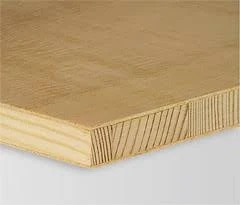What is Blockboard
Kistang -
Blockboard is a type of engineered wood product used in construction and furniture making. It is made by sandwiching a core of softwood strips or chips between two layers of hardwood veneer, and then bonding the layers together with adhesive and high pressure.
 |
| What is Blockboard ? |
Blockboards are commonly used for making furniture, such as shelves, cabinets, and tables, as well as for constructing interior walls, partitions, and ceilings. They are also used in the manufacturing of doors, panels, and other decorative items. Blockboards are known for their strength, stability, and durability, and they are often used as a substitute for solid wood boards because they are less expensive and more dimensionally stable.
Uses of Blockboards
Blockboards are used for a variety of purposes in construction and furniture making. Some common uses of blockboards include:
Furniture making
Blockboards are commonly used for making furniture such as shelves, cabinets, tables, and desks. They provide a stable and sturdy base for attaching legs, drawers, and other components.
Interior walls and partitions
Blockboards are also used in constructing interior walls and partitions. They provide a smooth and flat surface for painting or wallpapering, and are less likely to warp or shrink than solid wood.
Ceilings and flooring
Blockboards can be used as a base for installing ceiling tiles or as a subfloor for carpet or hardwood flooring.
Doors and panels
Blockboards are used in the manufacturing of doors, panels, and other decorative items. They provide a solid and durable surface that can be finished with paint, stain, or veneer.
Packaging
Blockboards can also be used in packaging and transportation to protect fragile or heavy items. They provide a sturdy and shock-resistant material that can withstand the rigors of shipping and handling.
Advantages of Blockboard
There are several advantages of using blockboards in construction and furniture making:
Strength and durability
Blockboards are made by sandwiching a core of softwood strips or chips between two layers of hardwood veneer, making them extremely strong and durable. They are less likely to warp or bend over time, and can withstand heavy use and weight.
Stability
Unlike solid wood, which can expand and contract due to changes in temperature and humidity, blockboards are less prone to dimensional changes. This makes them ideal for use in environments with high moisture levels, such as bathrooms and kitchens.
Cost-effective
Blockboards are less expensive than solid wood boards, making them a cost-effective alternative for furniture and construction projects.
Versatility
Blockboards can be used for a variety of purposes, including furniture making, interior walls and partitions, ceilings, and flooring. They are also used in the manufacturing of doors, panels, and other decorative items.
Smooth surface
Blockboards provide a smooth and flat surface that is ideal for painting, veneering, or laminating. They are also less likely to splinter or crack, making them safer to work with than solid wood.
Overall, blockboards are a versatile, cost-effective, and durable option for construction and furniture making.
Lack of Blockboards
The lack of blockboards in construction and furniture making can have some negative effects. Some of these include:
Limited design options
Blockboards offer a variety of design options due to their versatility and smooth surface. The lack of blockboards can limit the options available for construction and furniture making.
Higher costs
If blockboards are not available, builders and furniture makers may have to rely on more expensive materials such as solid wood, which can drive up the overall cost of the project.
Less stability
Blockboards provide a more stable base than solid wood, which can be prone to warping and shrinking. Without blockboards, there may be a greater risk of instability in the finished product.
Reduced durability
Blockboards are known for their strength and durability. The use of less durable materials can result in a finished product that is less resistant to wear and tear.
Environmental concerns
Blockboards are often made from sustainable materials, which makes them an environmentally-friendly choice. The lack of blockboards may result in the use of less sustainable materials, which can have a negative impact on the environment.
In summary, the lack of blockboards can limit design options, increase costs, reduce stability and durability, and have negative environmental impacts.
Types of Blockboards
There are several types of blockboards available, and they can vary based on the type of wood used for the core and the veneer, as well as the thickness and size of the boards. Here are some common types of blockboards:
Softwood blockboard
This type of blockboard has a softwood core, such as pine or spruce, and is usually used for construction purposes where strength is needed.
Hardwood blockboard
This type of blockboard has a hardwood core, such as oak or maple, and is often used for furniture making and decorative purposes where appearance is important.
BWR (Boiling Water Resistant) blockboard
This type of blockboard is made with a waterproof adhesive, which makes it resistant to water and moisture. It is commonly used in areas with high humidity, such as bathrooms and kitchens.
Fire-resistant blockboard
This type of blockboard is made with special fire-retardant chemicals and is used in areas where fire resistance is required, such as commercial buildings and public spaces.
Oversized blockboard
This type of blockboard is larger than standard-sized boards and is often used for construction purposes where larger panels are needed.
Lightweight blockboard
This type of blockboard has a lightweight core, such as balsa or foam, and is often used for applications where weight is a concern, such as in the aerospace and automotive industries.
These are just a few examples of the many types of blockboards available. The specific type of blockboard chosen will depend on the intended use and the desired properties of the finished product.
Characteristics of Quality Blockboard
Quality blockboards should possess certain characteristics that ensure their durability, strength, and suitability for use in construction and furniture making. Here are some characteristics of quality blockboards:
Core material
The core material of a quality blockboard should be made of high-quality, well-dried softwood strips or chips. The core should be free from defects such as knots, voids, and insect damage.
Veneer quality
The veneer on a quality blockboard should be smooth, uniform, and free from defects such as cracks, knots, and patches. The veneer should be made of high-quality hardwood, such as oak, birch, or maple, which will provide a durable and attractive surface.
Thickness and size
Quality blockboards should be uniform in thickness and size, with no visible warping or twisting. The thickness should be appropriate for the intended use, and should be consistent throughout the board.
Adhesive quality
The adhesive used to bond the core and veneer should be of high quality, and should be able to withstand exposure to moisture and temperature changes. The adhesive should be free from voids and should provide a strong and durable bond.
Resistance to moisture
A quality blockboard should be resistant to moisture and should not absorb water easily. The board should not warp or shrink when exposed to changes in humidity or temperature.
Straightness
A quality blockboard should be straight, with no visible bowing or twisting. The board should be free from surface defects such as splits, checks, and cracks.
Sustainability
Quality blockboards should be made from sustainable sources, with minimal impact on the environment. The production process should comply with environmental regulations and should minimize waste and emissions.
In summary, quality blockboards should possess a high-quality core and veneer, uniform thickness and size, strong adhesive bonding, resistance to moisture, straightness, and sustainability.

Post a Comment for "What is Blockboard"